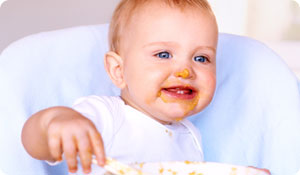
Food, glorious food! If your baby is sitting up on her own—and grabbing for your snacks—it may be time to introduce solids. Between the ages of 4 to 6 months, most babies are developmentally ready to get their first taste of big kid food!
Considering that baby food is little more than a smashed up version of what you're likely serving your family already, why not set aside some for baby? Although there are many healthy ready-to-eat options—including organic baby food—available today, you may want more control over what goes into your baby's mouth. Making your own baby food is a good way to do that and may be easier, less costly, and healthier than you think. With a little know how—and the right tools (as in fork for smashing, blender for pureeing)—you can become your baby's favorite chef.
According to the International Food Information Council Foundation, the goal of infant nutrition is to promote optimal growth and development by providing a variety of nutritious foods.
The group says home-prepared baby food is perfectly safe as long as the work areas are clean to prevent accidental contamination. Wash and rinse hands, equipment, and cutting surfaces before you begin and be sure to scrub and peel fruits and vegetables.
Babies tend to favor yellow and orange fruits and veggies such as carrots, squash, and bananas. You can expect a more varied reaction to green vegetables. Fresh vegetables that can be home prepared and pureed include potato, winter squash, sweet potato, peas, asparagus, and green or wax beans.
Pureeing canned or frozen fruits and vegetables can be a time saver, but be sure to check labels and avoid products with added sugar, salt, or fat.
Do it Yourself Cooking Tips
Steaming is the best way to make a meal for baby since it preserves the most nutrients. Boiling is another option but if you go that route, use as little water as possible since the less water used, the more nutrients stay in the food.
Once food is soft, puree using a blender, food processor, hand blender, or fork. Be sure to remove seeds and pits from fruit before attempting to puree it. Fully cooked meats (no pink) with skin and fat removed, beans, and cooked eggs can all be pureed for baby.
Do not offer honey, dairy, eggs, strawberries, tomatoes, citrus or nuts to babies less than 12 months old. Honey can be toxic in baby's immature digestive tract. The other foods are common allergens. Minimize allergic effects by introducing those foods at a later age.
Add a little liquid—water, breast milk, or formula—if necessary to achieve the desired consistence.
Store in the refrigerator or freezer. You can use an ice cube tray to freeze leftovers. To freeze: pour cooled, pureed food into a paper cupcake liner or a section of a clean ice cube tray, and cover with foil. Reheat frozen cubes in a heat-resistant container (glass is preferable to plastic due to concerns about Bisphenol A) or in a pan of hot water.
If you reheat in the microwave, be aware of hot spots caused by unequal heating and always test the temperature before offering to baby.
No Need to Count Calories
Babies have their own unique nutritional and developmental needs for fat, protein, fiber, sugar, and other nutrients. Infants can usually self-regulate the amount of calories they need each day so it's nearly impossible to overfeed them. For your information however, a 1-year-old needs an estimated 900 calories per day.
If you serve a variety of fruits and vegetables daily, while limiting juice intake, baby's meals will be balanced. Try to serve meals that contain at least one fruit and one vegetable.
Sources:
International Food Information Council Foundation
www.foodinsight.org
University of Maine, cooperative extension
http://umaine.edu
American Academy of Pediatrics
www.aap.org
American Heart Association
www.heart.org





